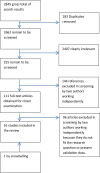The Performance of the Vaginal Discharge Syndromic Management in Treating Vaginal and Cervical Infection: A Systematic Review and Meta-Analysis
- PMID: 27706174
- PMCID: PMC5052075
- DOI: 10.1371/journal.pone.0163365
The Performance of the Vaginal Discharge Syndromic Management in Treating Vaginal and Cervical Infection: A Systematic Review and Meta-Analysis
Abstract
Background: This review aimed to synthesize and analyze the diagnostic accuracy and the likelihood of providing correct treatment of the syndromic approach Vaginal Discharge Flowchart in managing cervical infections caused by Neisseria gonorrhoeae (NG) and Chlamydia trachomatis (CT), and vaginal infections caused by Trichomonas vaginalis (TV) and Bacterial vaginosis (BV) and Candida albicans. This review will inform updating the WHO 2003 guidelines on Vaginal Discharge syndromic case management.
Methods: A systematic review was conducted on published studies from 01-01-2000 to 30-03-2015 in multiple databases. Studies evaluating the diagnostic accuracy and validation of the WHO Vaginal Discharge Flowchart were included. Validation parameters including sensitivity, specificity, positive predictive value (PPV) and negative predictive value (NPV) and the 95% confidence intervals for the different types of the flowchart were taken as outcomes, re-calculated, and analysed using a fixed model meta-analysis for data pooling. The level of agreement between the index and reference test were determined by the Cohen's Kappa co-efficiency test. Each individual study was assessed on quality using the QUADAS-2 tool.
Findings: The search yielded 2,845 studies of which 16 met the eligibility criteria for final analysis. The diagnostic performance to identify cervical infections was low and resulted in a high proportion of over and missed treatment. The four flowcharts had a sensitivity between 27.37% in history and risk assessment and 90.13% with microscopy, with the inverse in specificity rates. The treatment performances between the flowcharts were inconsistent. The same applies to the use of vaginal discharge flowchart for treating vaginal infections. For vaginal infections the vaginal discharge flowchart had a good performance in flowchart 3 with 91.68% of sensitivity; 99.97% specificity; 99.93% PPV and 0.02% who missed their treatment and 8.32% of women who were over treated by the vaginal discharge flowchart.
Conclusion: The vaginal discharge flowchart should focus on management of vaginal infection. It could be used as an intermediate approach for cervical infections for sex workers until a point of care test is available in resource poor settings.
Conflict of interest statement
The authors have declared that no competing interests exist.
Figures
References
-
- Organization WH. Global strategy for the prevention and control of sexually transmitted infections: 2006–2015. Breaking the chain of transmission. 2007.
-
- Organization WH. Guidelines for the Management of Sexually Transmitted Infections. 2003.
-
- Organization WH. Sexually transmitted and other reproductive tract infections. A guide to essential practice. 2005.
Publication types
MeSH terms
Substances
Grants and funding
LinkOut - more resources
Full Text Sources
Other Literature Sources
Medical
Miscellaneous


